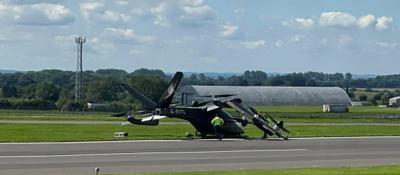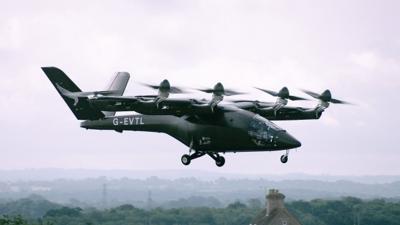Second Prototype Under Construction
Vertical Aerospace, the Bristol, UK-based concern that designs and manufactures Electric Vertical Takeoff and Landing (eVTOL) aircraft, announced on 09 August that its VX4 eVTOL prototype had suffered an accident during a test-flight at Gloucestershire, England’s Cotswold Airport (GBA).

The company set forth in its SEC filing: “Our flight-test program is designed to establish the limits of the aircraft’s performance, and the incident occurred during an uncrewed test of the aircraft’s maneuverability during a motor failure test scenario, which is a key requirement to progress to crewed operations.”
On 31 August, Vertical Aerospace reported the flight-testing mishap had been attributed to a material/bonding issue with one of the vehicle’s rotors.
In a press statement, the company explained: “The early-generation propeller had already been redesigned prior to the incident, with the issue fully resolved ahead of the next phase of testing. Further recommendations by the investigation [team] are being implemented by Vertical.”
The described fault derived, ostensibly, of a load-imbalance resultant of the intentional disabling of another of the VX4’s electrical propulsion units. The sudden and dramatic shifting of the aircraft’s mass and the lift-generating aerodynamic phenomena by which it was then borne aloft occasioned the failure of a supporting pylon structure.
Vertical’s engineering team asserted proprietary technologies, including the VX4’s high-voltage and battery systems, performed nominally during the incident. “Voltage, current, and power all stayed within acceptable limits, and cell temperatures were considered normal during and after the incident,” the company’s engineers concluded.
Vertical Aerospace committed to issuing a more comprehensive assessment of the occurrence once the U.K.’s Air Accident Investigation Branch (AAIB) completes its investigation thereof. In its preliminary report on the event, the AAIB suggested the rotor fault had caused “the aircraft to enter a stable descent before being damaged on impact with the ground.”
Setbacks notwithstanding, Vertical Aerospace asserted the VX4’s thrust-borne flight test campaign has been successfully completed, with the aircraft having achieved its target speed of forty-knots and “demonstrated exceptional overall stability and control.” The company reported, also, that performance targets for the remotely piloted, untethered flights were generally exceeded by ten-to-thirty percent during hover and low-speed flights.
In an initial report detailing the summer 2023 VX4 flight-testing regimen, Vertical Aerospace set forth: “The prototype performed especially well in sustained hover, typically the most challenging regime for a VTOL aircraft, where it maintained level flight for longer than anticipated. The aim of these thrust-borne flight tests was to verify acceptable stability, battery efficiency, and control characteristics, aerodynamics, structural loads, performance, and vibration throughout this speed range—all of which were achieved.”
Stressing that type certification timelines for the program remain unchanged, Vertical Aerospace disclosed its personnel are working to build a second full-scale prototype, which would be ready, conceivably, to take flight in the latter half of 2024. The company claims the second prototype will have “greater capabilities than our first prototype, including improved range and higher performance, particularly in hover.” Key program partners include: Honeywell, GKN Aerospace, Hanwha, Solvay, Leonardo, and Molicel.
Vertical Aerospace founder and CEO Stephen Fitzpatrick remarked: “We are pleased with our flight test progress to date and the data, insights, and invaluable learnings we have collected. While a fault of any sort is disappointing, it is not wholly unexpected at this stage of testing a novel aircraft. I am pleased that as a result our expert team has isolated the cause of the fault and has been able to provide the AAIB with our report within 14-days of the incident.”

The aircraft damaged on 09 August will henceforth be plied to ground-testing exclusively. Moreover, the rotor-blade architecture peculiar to subject aircraft will not be used on future prototypes.
Vertical Aerospace’s VX4 is a piloted, eVTOL aircraft ostensibly capable of transporting four passengers and a pilot over a distance of 86-nautical-miles at speeds of up to 173-knots. The VX4 is intended to operate from confined, urban locations and is—according to its manufacturer—"safer than and one-hundred-times quieter than a conventional helicopter.”
Vertical has already sold significant numbers of its VX4 to customers across the aviation industry. The company’s clients include major air-carriers such as American and Virgin Atlantic Airlines, charter operators and aircraft brokerages such as Avolon and Bristow, and commercial helicopter operators.
To date, Vertical Aerospace’s books contain orders for 1,400 VX4 aircraft representing a total value of $5.6-billion.
 ANN's Daily Aero-Linx (04.30.25)
ANN's Daily Aero-Linx (04.30.25) ANN FAQ: Turn On Post Notifications
ANN FAQ: Turn On Post Notifications Classic Aero-TV: Agile Aeros Jeff Greason--Disruptive Aerospace Innovations
Classic Aero-TV: Agile Aeros Jeff Greason--Disruptive Aerospace Innovations Aero-News: Quote of the Day (04.30.25)
Aero-News: Quote of the Day (04.30.25) ANN's Daily Aero-Term (04.30.25): Expedite
ANN's Daily Aero-Term (04.30.25): Expedite




